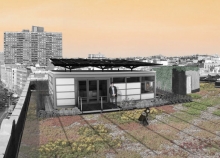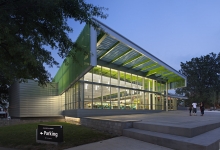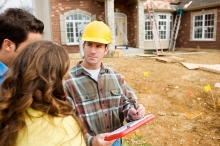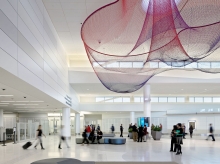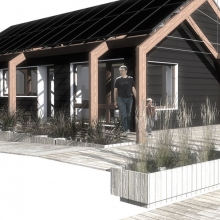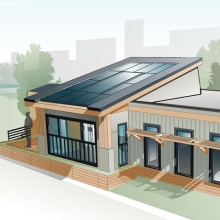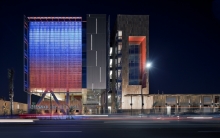Imagine that all of New York City’s rooftops are covered with photovoltaic panels. They could provide enough electricity to meet around 14% of the city’s needs, according to calculations by Tria Case, one of the City College of New York's directors. Comprised of students from The City College of New York’s (CCNY) Bernard and Anne Spitzer School of Architecture and Grove School of Engineering, Team New York, who are competing for the first time this year in the Solar Decathlon, asserts that NYC’s roofscape is vastly underutilized, not only for its potential in collecting solar energy but also for its potential to provide prime living and outdoor space for its citizens. Their design for the Solar Roof Pod could prove a versatile and sustainable solution.
AEC Pros
Taking a Look at Smog-Fighting Technologies
Organizations and manufacturers have been researching green building materials for years now, inundating the market with a wide spread of green products for sustainably inclined developers and builders. Recently developed products go beyond the reduction of emissions and waste to the elimination of pollutants from the atmosphere. New smog-fighting technologies and products are still in testing, but some will be available for purchase by 2012. With their introduction to the marketplace, however, comes a myriad of questions.
Anacostia Library by Freelon Group
Libraries, in essence, are outdated. Why crack open a dusty old tome when you can just “Google it?” In order to stay relevant, some libraries are shifting toward a new model, simultaneously serving as technology hubs and community centers. The new Anacostia Library in Washington, D.C., designed by the Freelon Group along with Associate Architect R. McGhee & Associates, exhibits the qualities of a 21st century library. Its eco-friendly design welcomes the neighborhood and doubles as an educational tool for children.
Tools That Facilitate the LEED for Homes Certification Process
In 2008, the United States Green Building Council (USGBC) launched its LEED (Leadership in Energy and Environmental Design) for Homes program with the intent of capitalizing on the momentum of other LEED programs and revolutionizing the way homes are built. Since the inception of LEED for Homes, more than 10,000 LEED homes have been certified, providing builders a way to differentiate the products that they offer. It has also given home builders the opportunity to provide homes with higher marketability. Making the transition from traditional home building to green home building can be a daunting task: the following tools will facilitate the building of a LEED-certified home.
GPS Machine Control Creates Opportunity in the Surveying Industry
Technological innovation always shakes up an industry, and the surveying industry is no exception. All throughout surveying, machine guidance systems are gaining acceptance. The increased adoption of this technology by the industry is renewing the importance of surveyors. Machine guidance systems require skilled workers to calibrate and operate, and surveyors are in the best position to do this job. In order to capitalize on the opportunity, surveyors will need to learn to use machine guidance and promote their new skill.
In 2008, San Francisco International Airport (SFO) began renovation of its Terminal 2M (SFO T2). While airport expansions and renovation have become commonplace, global design and planning firm Gensler aspired to nothing less than a paradigm shift with this 640,000 sq. ft. project.
Traditional farming requires huge inputs to sustain it, from water to potentially hazardous pesticides to fertilizers. After food is grown by conventional agricultural methods, it must be stored, refrigerated, and transported to the urban centers where it will be consumed, making traditional farming highly pollution-producing. Vertical Urban Agriculture has the potential to solve this problem and could lead to urban and environmental renewal on a fantastic scale for India’s cities.
2011 Solar Decathlon: Team Massachusetts' 4D Home
Because the Solar Decathlon competition stipulates that homes’ interiors measure less than 1,000 sq. ft., many teams choose young or retired couples as their target market. However, Team Massachusetts, which is comprised of students from the Massachusetts College of Art and Design and the University of Massachusetts at Lowell, created a home fit for a family of three. They articulated spaces with flexibility in mind in order to meet occupants’ changing needs throughout their lives: the 4D Home is three-dimensional over time.
In today’s on-the-go society, we have the capability of conducting work on smartphones to increase productivity. Beyond making calls, sending texts, and keeping track of our schedules, smartphone apps significantly enhance the user’s experience and enable them to conduct business outside the office proper. Particularly in the AEC industries, smartphone apps have become increasingly popular. These apps are more than mere gadgets; they provide functions similar to those of the tools that are traditionally used in the industry.
2011 Solar Decathlon: Tidewater Virginia's Unit 6 Unplugged
Many Solar Decathlon entries make futuristic propositions for green living, but the Tidewater Virginia team chose to design their house by using a familiar language. Their target market is the Tidewater region of southeastern Virginia, specifically the dense, middle-class neighborhoods of Norfolk, home to many military families. Designed as urban infill, Unit 6 Unplugged draws inspiration from its Arts and Crafts context and provides an affordable housing option for a working couple.
Chandler City Hall: Spurring Future Development
The recently opened, award-winning Chandler City Hall in Arizona, a $47 million complex that covers two city blocks, seeks to express the new economy that has come to this "Old West" town. Founded in 1912, the town of Chandler spent its early decades as a quiet agricultural and ranching community. More recently, it has experienced a population boom and expanded its economic base to include electronics and manufacturing. As Chandler extended its town borders, it was also forced to decentralize its municipal offices, which came to occupy various leased spaces.
Erosion Control Grows Up
When I began my career in the engineering/construction industry 37 years ago, erosion from construction sites was never a stated concern. None of the huge water treatment plants and wastewater treatment plants I designed had any provisions for preventing erosion or controlling sediment. The streams, lakes, and rivers downstream from my sites no doubt did a lot of natural “settling” and maybe “filtration.”
